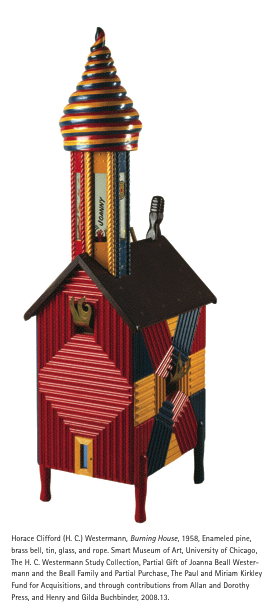The exhibition Your Pal, Cliff at the University of Chicago’s Smart Museum features art objects as well as ephemera derived from the collection donated to the museum by the estate of Westermann’s widow, Joanne Beal Westermann. Getting a chance to encounter even one of Westermann’s works is always cause for celebration, so it is a true windfall to see a show of this magnitude. Not since the MCA’s excellent 2001 retrospective has there been a comprehensive exhibition of his work.
Westermann’s work is notable for its profusion of diverse source material. Notable for their sophisticated and humorous linguistic and philosophical play, the objects combine a Donald Judd-like interest in the well-made (perhaps indicating a shared affinity for Shaker and other American craft traditions) with an interest in vernacular architecture, like roadside grottos or urban churches. However, unlike Judd, Westermann’s well-made objects are the product of his own fastidious hands. The two-time Marine Corp veteran and sometimes acrobat’s carpentry skills are matched only by the sincerity of his expressive syntax of forms. The objects are distinguished for the way in which they fuse a myriad of sources to produce a strikingly direct and profound result, that somehow exhibits both multiplicity and specificity.
Westermann’s prints, drawings and letters are equally compelling in their combination of personal, collective and vernacular histories. While it is difficult to envision a peer group for an artist as singular as Westermann, artists such as Judd, Claes Oldenburg, John Wesley, Jasper Johns, Richard Artschwager, Joseph Yoakum and Yayoi Kusama do come to mind. However, even the diversity of this hypothetical grouping is still an inadequate measurement of what Westermann is really up to.
To stop one’s inquiry at the level of form or process is to neglect the unparalleled integration of Westermann’s life and art—Westermann’s home and workshop in Connecticut, built from the ground up in collaboration with his wife, is a testament to this fusion. While on the visiting artist circuit in the 1970s, Westermann would skip the requisite artist talk in favor of going out with his wife, their dog and the graduate students. While buying beers for the grads, he would tell stories of war, adventure and craft.
The integration of his mode of expression, manner of living and personal comportment suggest a genuineness (worlds apart from the perversions and nonsense of the mainstream art world). It is impossible to put Westermann’s art in brackets; it necessarily bleeds into his life, and—while his is an extraordinary story—there is something for everyone embedded in his richly textured formal grammar.
On view through Sept 6, The David and Alfred Smart Museum of Art, The University of Chicago, 5550 S. Greenwood Avenue, 773-702-0200. Hours: Tues–Wed & Fri 10am–4pm, Thurs 10am–8pm, Sat–Sun 11am–5pm.









